
Investing.com – The U.S. dollar fell on Tuesday even as U.S. short-term rates remained steady, helped by a broader decline in intermarket volatility and rising risk appetite among investors. The shift is partly explained by expectations of a soft economic landing in the US, a scenario that investors are preparing ahead of the upcoming release of core PCE inflation data.
The core personal consumption price index (PCE) for April is scheduled to be released on Friday, with market consensus forecasting a modest 0.2% month-on-month increase. The figure, which is in line with previously released April Consumer Price Index (CPI) and Producer Price Index (PPI) data, is critical as it could change expectations for a potential Federal Reserve rate cut in September, which is currently estimated at 44 percent likely. %. Confirmation of favorable inflation could put further pressure on the dollar.
Today’s economic calendar will show home price data for March and consumer confidence data for May. The latter is especially notable as consumer confidence has been trending lower since January, raising concerns about whether spending by the top 20% of income earners can continue to offset the economic woes of the bottom 60%. ING suggests that higher interest rates could ultimately lead to lower consumer spending and slower US economic growth throughout the year.
The Index (DXY), a measure of a currency’s value against a basket of other major currencies, is approaching critical support at 104.40. This threshold represents the lower limit of the dollar’s rally this year. A fall below this point could signal that investors with long dollar positions may begin to reduce their exposure in anticipation of important data release later in the week.
This article was created with the help of AI and reviewed by an editor. For more information please see our Terms and Conditions.


